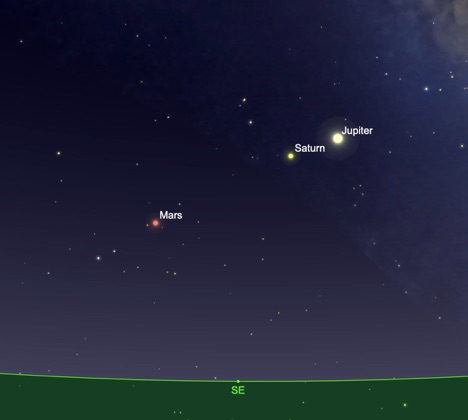Sky Report April 20-26

The first “star” to appear after sunset tonight is the poetically named “Evening Star” – the planet Venus. Venus appears high in the southwest as the sky grows dark, and it outshines every other object in the sky (except the moon) until it sets in the west sometime before midnight. The planet Venus is about the same size as the earth and is 44 million miles distant – currently the closest planet to earth – but what makes it so bright is that it’s covered by dense white clouds that reflect the sun’s light earthward, like a mirror. These clouds also prevent us from seeing through them to its surface.
This week Venus is in the constellation Taurus, the Bull. To the lower-left left of Venus is the bright orange star Aldebaran which marks the eye of the Bull, and a similar distance below and slightly to the right of Venus is the Pleiades, or Seven Sisters, star cluster. Look at the Pleiades with binoculars; how many stars can you see?
Three bright planets are lined up in the morning sky and you can see them best from 5 to 6 a.m., in the southeast. From left to right they are Mars, Saturn, and Jupiter. Jupiter is by far the brightest, while Saturn and Mars are 1/13th as bright as Jupiter. Mars is slowly moving eastward night by night and it’s slowly increasing its distance from Saturn and Jupiter. Notice Mars’ orange color.
The moon is new on Wednesday the 22nd. On that and the following night it will set too early and be too low to see, but you might spot it on Friday the 24th – and even then it will be an especially thin crescent. Look for it very low in the west north-west in evening twilight at about 9 pm. On the next night you should have little trouble spotting it, still at 9 pm. On the 25th the moon is a very short distance (3-1/2 degrees) to the right of the star Aldebaran (mentioned above) and on the following night, the 26th, the moon is to the left of Venus (7-1/3 degrees). On both nights the moon and either the star Aldebaran or the planet Venus will fit in the field-of-view of wide-angle binoculars and you can view them both simultaneously.
We had hoped that newly discovered Comet Atlas (2019 Y4) would become visible to the naked eye later this month and in May, but it seems to be breaking apart and fading. You can see it with a small telescope (but not binoculars) if you know where to look; go to www.Heavens-Above.com for finder charts.
The Lyrid meteor shower 2020 peaks before twilight on the morning of April 22. Lyrids are the remains of the Comet Thatcher and could produce 10 to 18 meteors an hour including a few fireballs for those living in dark locations. You may see Lyrids on April 21, 22 & 23, but you must be a true night owl as they originate in the sky near the constellation Lyra, which at this time of year rises in the East over southern Utah after midnight. To find it, look for the bright star Vega. Heading outside between 3 am and 5 am gives you the best chance to witness a few of these infrequent meteors streaking through the night sky! There will be no moon to interfere with viewing the Lyrids this year.
Finally, don’t forget International Dark Sky Week, a celebration of the wonders of the night sky beginning April 19 with a week-long series of lectures and presentations sponsored by the International Dark Sky Association. Find out more here: https://idsw.darksky.org/?eType=EmailBlastContent&eId=c152a9b1-13f0-4a8e-a28f-f59b3a56cf48
The Sky Report is presented as a public service by the Stellar Vista Observatory, a nonprofit organization based in Kanab, Utah, which provides opportunities for people to observe, appreciate, and comprehend our starry night sky. Additional information is at www.stellarvistaobservatory.org. Send questions and comments to John@StargazingAdventures.org.






Comments are closed.